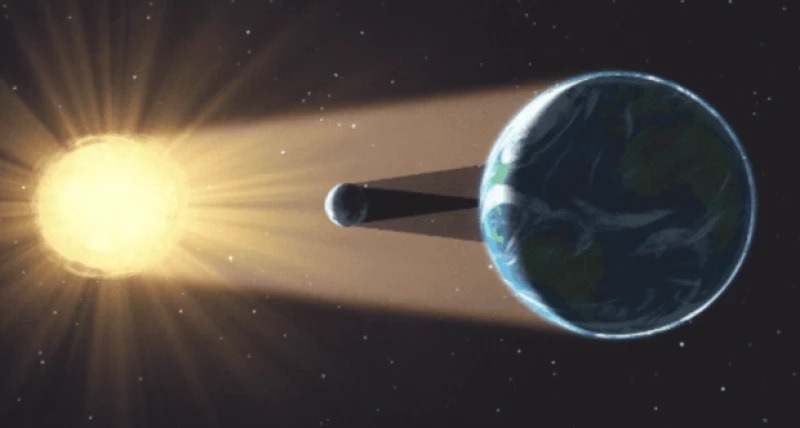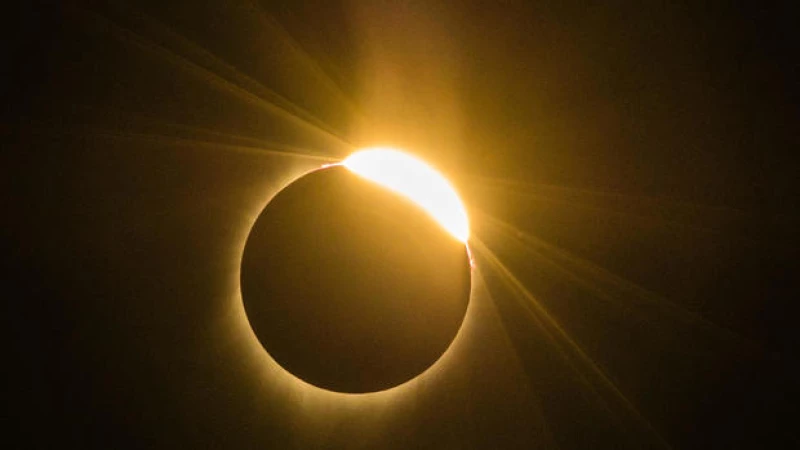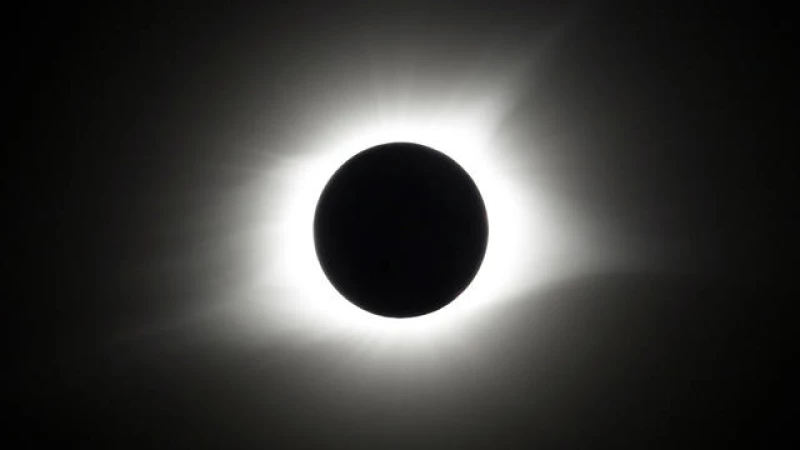The upcoming total solar eclipse will occur on Monday, April 8, as the sun and the moon align to darken daylight skies over parts of North America. This event will be the first total solar eclipse in the United States since August 2017, and experts suggest that it may be even more impressive than the previous one.
Here is some information about total solar eclipses and why they happen.
What is a solar eclipse?
Solar eclipses occur when the sun, moon, and Earth align in space. This alignment causes one celestial body to obscure another, depending on the moon's position relative to the sun and Earth. During a lunar eclipse, such as the one that occurred over much of the Western hemisphere in late March, all three bodies align with Earth in the middle. This alignment sometimes allows observers to witness Earth's shadow moving across the moon's surface, illuminated by the sun's rays.
The Phenomenon of Total Solar Eclipses
During a total solar eclipse, the alignment of celestial bodies creates a captivating spectacle. The moon, orbiting Earth, moves between the planet and the sun, appearing to cross directly in front of the star and temporarily blocking its light. This unique positioning causes a shadow of the moon to be cast onto Earth.
Individuals within the narrow path of this shadow experience a remarkable transformation as day turns into twilight while the moon passes overhead along its orbit. The total solar eclipse offers a tangible connection to the vastness of the universe, making astronomical concepts visible to the naked eye.
Understanding the Occurrence of Total Solar Eclipses
Total solar eclipses are a result of the intricate dance of celestial bodies in our solar system. Due to Earth's orbit around the sun and the moon's orbit around Earth, eclipses happen several times a year worldwide, with total eclipses being rarer occurrences.
Michael Kirk, a research astrophysicist, explains that the occurrence of a total solar eclipse depends on the precise alignment of various factors such as the distance between Earth and the moon, Earth's orbit, and the sun's position in the sky. When these elements align perfectly, a total solar eclipse takes place, providing a breathtaking display of cosmic harmony.
Solar eclipses are a breathtaking sight from Earth, a phenomenon that scientists attribute to a remarkable cosmic alignment. The sun's diameter is about 400 times larger than the moon's, and its distance from Earth is approximately 400 times farther than the moon's. This unique ratio creates the illusion that the sun and moon are similar in size when viewed from our planet, leading to the potential for awe-inspiring solar eclipses where the moon can obscure all or part of the sun.

Solar eclipses can only take place during a new moon, a significant phase in the lunar cycle. New moons occur approximately once a month when the moon's orbit around Earth intersects with Earth's orbit around the sun, positioning the moon between the Earth and the sun. A similar alignment occurs during a full moon, but with Earth in the middle instead.
Similar to Earth, the moon experiences its own version of day and night based on its position relative to the sun during its orbit. When sunlight reflects off half of the moon's surface, observers on Earth see the illuminated, sunlit side as moonlight.
During a new moon, none of the sunlit side of the moon faces Earth, causing it to appear as a dark silhouette blocking the sun during a solar eclipse. However, solar eclipses do not occur with every new moon phase.

The Science Behind Solar Eclipses
While the moon regularly passes by the sun, the perfect alignment needed for a solar eclipse is often elusive. This is due to the moon's orbit around Earth being tilted compared to Earth's orbit around the sun. When the orbits intersect during a new moon, they do so at an angle. This slight angle, approximately five degrees, disrupts the alignment, causing the new moon to pass either above or below the sun's light beam on Earth, rather than through it. The moon's tilted orbit also explains why lunar eclipses do not occur monthly like full moons.
What Happens During a Solar Eclipse?
As the new moon moves directly between Earth and the sun, the sunlight still visible around the moon creates a shadow that falls on a portion of the Earth. The moon's orbit, combined with Earth's movement and rotation, causes this shadow to travel across the planet's surface. This traveling shadow, known as the path of totality, creates a total solar eclipse experience within its boundaries.
According to Kirk, an expert in the field, observing the eclipse shadow passing over you allows for a real-time observation of the moon's orbit on a human scale. Witnessing the eclipse shadow move rapidly during totality provides a visual representation of the moon's orbit in action.
The moon is closer to Earth now than it was during the total solar eclipse that dazzled millions of Americans in 2017, so tomorrow's spectacle will have a much wider path of totality. That presents a unique opportunity for many across the country to witness a total solar eclipse, perhaps for the first time. In the contiguous United States, there will not be another chance for 20 years.
Monday's eclipse will see the moon temporarily blot out the sun in skies over a vast stretch of North America, moving from the Pacific Coast of central Mexico to the southwestern U.S., the Midwest, the Northeast and New England before tapering off in far-eastern Canada. Millions of people are flocking to places inside the path of totality, which includes cities like Dallas and Buffalo, for the show.
As the eclipse passes overhead, people watching should see afternoon light fade to resemble something like dusk or dawn. But anyone who decides to look up, even through a camera lens, needs to wear specialized protective glasses.
Weather permitting, observers in the path of totality may also be able to see wisps of the sun's outermost atmosphere, called corona. They could potentially see a coronal mass ejection, too, which is essentially an eruption of solar material from that outer layer. Unlike the total solar eclipse in 2017, this one comes in the midst of an especially active and energetic period for the sun.
Exploring the Unique Nature of a Partial Solar Eclipse
Individuals situated just outside the path of totality tomorrow may have the opportunity to witness a partial solar eclipse. This type of eclipse occurs when the moon moves between the sun and the Earth without perfect alignment. Observers within the path may witness partial eclipses both before and after totality. When viewed from Earth, the moon appears to cover only a portion of the sun during a partial solar eclipse, sometimes creating the iconic crescent shape typically associated with moonlight.

Partial, total, and annular are not the only classifications of eclipses. Another variation is the annular eclipse, where the conditions for a total solar eclipse are met, but the moon is positioned at or near the farthest point from Earth in its elliptical orbit. Similar to the annular eclipse that occurred last October, the increased distance causes the moon to appear smaller against the backdrop of the sun during an eclipse, resembling a dark spot surrounded by a fiery ring. In certain scenarios, eclipses can transition between an annular display and totality.
Unraveling the Factors Influencing the Timing of a Solar Eclipse
The upcoming solar eclipse is set to commence over the South Pacific Ocean tomorrow, as indicated by NASA. The event is projected to make its first landfall in coastal Mexico around 11:07 a.m. PDT. The period of totality will be most prolonged near the onset of the eclipse's trajectory, in an area roughly 25 minutes northwest of the city of Torreón. There, for a duration of up to 4 minutes and 28 seconds, the sun will be obscured by the moon's shadow, creating a captivating celestial display.
Earth's rotation guides the path and timing of an eclipse as much as the moon's orbit. Whichever spot on the planet's surface finds itself exactly aligned with the moon when the moon aligns with the sun is where the eclipse "begins." In this case, that spot is somewhere in the South Pacific. But the moon's position changes in orbit while the planet turns as the day goes on, and their calibration with the sun eventually falls out of alignment. The eclipse "ends" at the spot on Earth's surface where alignment is intact for the last time.
How long totality lasts in any given place is based on the curvature of the Earth, and the distance between its surface and the moon during a solar eclipse.
"The peak eclipse is where the moon is closest to the Earth's surface and the most aligned with the sun," said Kirk. "So, as that alignment gets off from the ideal peak, and you move around on the Earth's surface because the Earth is round, that curvature brings you out of perfect alignment just a little bit. That means the length of time that you get that perfect alignment between the Earth, sun and moon to get totality is just a little bit shorter, and a little bit shorter."
Following the departure of tomorrow's eclipse from Mexico, totality will make contact with regions in Texas, Oklahoma, Arkansas, Missouri, Illinois, Kentucky, Indiana, Ohio, Pennsylvania, New York, Vermont, New Hampshire, and Maine. Limited areas in Tennessee and Michigan will also witness the phenomenon. As the eclipse traverses the U.S., it is projected to enter Canada through Southern Ontario, proceeding to Quebec, New Brunswick, Prince Edward Island, and concluding at Cape Breton. The eclipse will bid farewell to continental North America at 5:16 p.m. in the local time zone on Newfoundland's Atlantic Coast.
The duration of darkness in each location within the path of totality will gradually decrease. Nevertheless, regions along the eclipse's trajectory will experience it for a noticeable period, with scientists approximating that even parts of Canada at the furthest end will encounter totality for up to 3 minutes and 21 seconds.
In comparison, the longest totality duration observed during the 2017 solar eclipse was a mere 2 minutes and 42 seconds, near Carbondale, Illinois. Furthermore, NASA has calculated that 99% of individuals in the U.S. will witness the upcoming solar eclipse to some extent — whether partially or in totality — irrespective of their location. This includes areas in Alaska and Hawaii.







